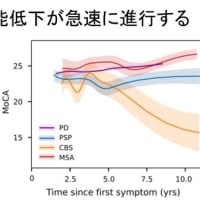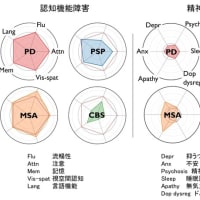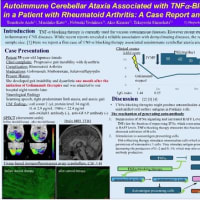Clinically isolated syndrome(CIS) は,「最初のエピソードからなる症候群」と邦訳されるが,MSの早期の臨床的なエピソードと考えられ,具体的には①視神経炎,②脳幹症候群,③脊髄炎,④その他(hemisphericもしくはpoly-regional)からなる症候群である(Neurology 53:1184,1999).よって時間的空間的多発性を証明できていないためMSではないものの,今後,MSに移行する可能性がある状態を指す.これまで視神経炎で発症した症例は予後が良いとの報告がある一方,臨床的・画像的検討から予後の違いを見出せないとの報告もあった.
今回,SpainよりCISの症状の違いによりsecond attackの頻度が異なるか,また画像所見上その後の経過に違いが見られるかについての研究が報告された.方法としてはCIS 320症例を平均39ヶ月間経過観察し,初回発作から3ヶ月以内と,さらに12ヵ月後にMRIを評価した.結果として,CISのタイプの内訳は①視神経炎123名,②脳幹症候群78名,③脊髄炎89名,④その他30名であり,各群間で年齢,性別,罹病期間に有意差はなかった.最初のMRIにて異常所見を認めなかったのは全体では33%,分類別では①視神経炎49.2%,②脳幹症候群24%,③脊髄炎24%,④その他18.5%で,視神経炎の場合,有意にMRI異常の合併は低率であった.Clinically definite MSへのconversionは全体で111名において生じ(34.7%;平均19.8ヶ月,中央値13.9ヶ月),分類別では①視神経炎36.6%,②脳幹症候群57.7%,③脊髄炎49.4%,④その他63.3%であった.さらにMRI上,McDonald基準の空間的多発を満たした割合も視神経炎では有意に低かった.しかし,初回発作時にMRI異常を認めた症例のみで各郡を比較してみると,臨床的・画像的に有意差を見出せなくなった.
以上の結果は,視神経炎で発症したCISはMSへのconversionの率が有意に低いことを確認したものであるが,CISの症状に加え,初回MRIでの異常の有無も,予後を予測する上で重要であることを明らかにした.
Ann Neurol 57; 210-215, 2005
今回,SpainよりCISの症状の違いによりsecond attackの頻度が異なるか,また画像所見上その後の経過に違いが見られるかについての研究が報告された.方法としてはCIS 320症例を平均39ヶ月間経過観察し,初回発作から3ヶ月以内と,さらに12ヵ月後にMRIを評価した.結果として,CISのタイプの内訳は①視神経炎123名,②脳幹症候群78名,③脊髄炎89名,④その他30名であり,各群間で年齢,性別,罹病期間に有意差はなかった.最初のMRIにて異常所見を認めなかったのは全体では33%,分類別では①視神経炎49.2%,②脳幹症候群24%,③脊髄炎24%,④その他18.5%で,視神経炎の場合,有意にMRI異常の合併は低率であった.Clinically definite MSへのconversionは全体で111名において生じ(34.7%;平均19.8ヶ月,中央値13.9ヶ月),分類別では①視神経炎36.6%,②脳幹症候群57.7%,③脊髄炎49.4%,④その他63.3%であった.さらにMRI上,McDonald基準の空間的多発を満たした割合も視神経炎では有意に低かった.しかし,初回発作時にMRI異常を認めた症例のみで各郡を比較してみると,臨床的・画像的に有意差を見出せなくなった.
以上の結果は,視神経炎で発症したCISはMSへのconversionの率が有意に低いことを確認したものであるが,CISの症状に加え,初回MRIでの異常の有無も,予後を予測する上で重要であることを明らかにした.
Ann Neurol 57; 210-215, 2005





















Persisting poliovirus fragments in patients with post-polio syndrome and
enhanced cytokine production in cells exposed to the patients’ PBLs
PPS患者における持続するポリオウイルス断片およびPBLs(注:末梢血白血球)にさらした細胞中のサイトカイン産生の増強。
Andreina Baj,GiuseppeMACCARI,and Antonio TONIOLO
イタリア Varese,Insubria 医科大学 微生物研究所
急性麻痺発症の数十年後、PPS-新規の筋肉脆化、慢性疲労、苦痛、および他の症状で特徴付けられるーを発症した一団のポリオ生存者を調査した(1)。
PPSの原因は不明である(2)。異なるエンテロウイルス受容体を示す細胞株と分子試験(3、4)を用いて調査した所、低レベルの伝染力とPVゲノム断片が、64人のPPS患者(平均年齢58歳、感染後の平均期間53年)のうち、54人(84.4%)のCSF(注;脳脊椎液)と末梢血白血球(PBLs)から検出されている。
58名の対照群(献血者,n=26:PPS患者の家族,n=21:PPS以外の神経性疾患を患う成人、n=11)のPVゲノム断片を同様な方法で調査した所、わずか2名のみに検出された。
手術を行った、わずかのPPS患者の組織培養では、PVゲノム断片は骨格筋、末梢神経、十二指腸と結腸の粘膜細胞の初期培養物に検出されている。
PVゲノム断片の量は極めて僅かであり、ゲノムシーケンシングを困難にしている。5'UTR,VP1,および3Dpolの単位複製配列を一部シ-ケンシングした結果、ウイルスのシーケンスはPV-1(症例の70%)、PV-2、およびPV-3(それぞれ16%、8%)の参照株と一致した。
PVー特異mAbs(モノクローナル抗体)による試験では、カプシド蛋白質がPPS患者の末梢血白血球にさらした上皮細胞株で産生されたことがわかった。
Hela細胞培養物を患者の末梢血白血球(n=29)に晒(さら)した1月後の4-5代継代させた培養物は、健康な献血者/PPS患者の家族(n=15)の末梢血白血球に同様に晒したHela細胞培養物(n=15)と比較して、それぞれ7.9倍、2.6倍のMCP-1とIP-10を放出した。10の追加のサイトカインのレベルは相違なかった。
このデータから、PVゲノム断片と幾分かの生物活性がポリオ生存者中に数十年、まさに存続することがわかる。
PPS患者に存続するPV株を特性評価することは、病因の理解とこの身体障害に対する治療法の発見に役立つだろう。
謝辞:この研究は国際ポストポリオ健康財団(St.Louis、MO)とRegione Lombardia(Milan,IT)の援助を受けた。 (翻訳:近見)
F36 国際picornavirus分子生物学会 2010 9.11-16 Scotland
Persisting poliovirus fragments in patients with post-polio syndrome and
enhanced cytokine production in cells exposed to the patients’ PBLs
Andreina Baj1, Giuseppe Maccari1, Michele Stefanoli1, Giorgio Bono2, and Antonio Toniolo1
Institute of Microbiology1 and Institute of Neurology2, University of Insubria Medical
School, Varese, Italy
Decades after the acute paralytic episode, we investigated a cohort of polio survivors
who developed the “post-polio syndrome” (PPS), a progressive condition characterized by new muscular weakness, chronic fatigue, pain, and other symptoms (1). Etiology and pathogenesis of PPS are undefined (2). Using cell lines expressing different enterovirus receptors and molecular tests (3, 4), low-level infectivity and PV genome fragments have been detected in CSF and peripheral blood leukocytes (PBLs) of 54/64 (84,4%) PPS patients (median age, 58 yrs; median time since APP, 53 yrs).
Using the same methods,PV genome fragments could be detected in only 2 of 58 controls (blood donors, n=26; family members of PPS patients, n=21; adult pathologic controls with neurologic conditions other than PPS, n=11).
In tissues of a few PPS patients who underwent surgery, PV genome fragments have been detected in primary cultures of skeletal muscle, peripheral nerve, duodenal and colonic mucosa cells.
Extremely low levels of PV genome fragments were present.
This made genome sequencing difficult.
Partial sequencing of 5’UTR, VP1, and 3Dpol amplicons indicated that viral sequences were compatible with reference strains of PV-1 (70% of cases), PV-2, and PV-3 (16% and 8% of cases, respectively).
Assays with PV-specific mAbs showed that capsid proteins were produced in epithelial cell lines exposed to PBLs of PPS patients.
One month after exposure of HeLa cell cultures to patients’ PBLs (n=29), the cultures (subjected to 4-5 passages) released enhanced levels of MCP1 and IP10 (7.9 and 2.6-fold, respectively) as compared to HeLa cultures (n=15) equally exposed to PBLs of healthy blood donors/family members of PPS patients (n=15).
Levels of 10 additional cytokines were not different.
The data indicate that PV genome fragments and some biological activity
do persist for decades in polio survivors.
Characterization of persisting PV strains in PPS patients will contribute to understanding pathogenesis and finding a cure for this disabling condition.
Acknowledgments: work supported by Post-Polio Health International (St. Louis, MO) and
Regione Lombardia (Milan, IT).
A randomized controlled trial
ポストポリオ症候群に関する免疫グロブリン静脈内注射IVIgによる無作為比較試験
Henrik Gonzalez Division of Rehabilitation Medicine, Department of Clinical Siences,Danderyd Hospital,Stockholm,Sweden
Katharina Stibrant Sunnerhagen Institute of Nuroscience and Physiology,Rehabilitation Medcine,Göteborg University
Inger Sjöberg Department of Nuroscience ,Rehabilitation Medcine,University Hospital Uppsala,Uppsala,Sweden
Georgios Kaponides Department of Public Health Sciences,Karolinska Institute,Stockholm,Sweden
Tomas Olsson Neuroimmunology Unit,Department of Clinical Neuroscience,Karolinska Hospital, tockholm,Sweden
Kristian Borg Department of Public Health Sciences,Karolinska Institute,Stockholm,Sweden
Lancet Neurology, 2006; 5: 493-500 DOI:10.1016./S1474-4422(06)70447-1
注)訳者、編集者などはこの翻訳内容と、それによって引き起こされた事に対して、いかなる責任も負いません。
Summary 要約
Background 背景; 急性灰白髄炎(ポリオ)の生存者には,急性感染した後に数十年経って,症状が増悪したり,あるいは新しい症状が出現したりすることがよくある.これはポストポリオ症候群として知られている.CNS(Central Nerve System; 中枢神経系)での炎症進行過程でサイトカインの産生は,炎症過程の基礎を成し免疫調整システムに関する治療が可能であることを示している.我々はポストポリオ症候群の免疫グロブリン静脈内注射(静注)に関して,複数施設でランダム化比較試験(二重盲検、プラセボ比較)を行った。
Method 方法; 4つの大学病院で142名の患者が,免疫グロブリンを合計90g静注するグループ(n=73)とプラセボグループ(n=69)に無作為に割り当てられ,連続3日間の静注が行われ,これを3ヶ月後に繰り返した.7名の患者がこの研究から脱落した.したがって135名がプロトコルごとに評価された.一次評価ポイントは被験筋の筋力,SF-36質問票(SF-36 PCS)による生活の質であった.二次評価ポイントは,6分間歩行テスト(6MWT),Time up and go(TUG)テスト,被験筋に選ばれていない筋の筋力,高齢者の身体活動スケール(PASE),痛みの視覚化スケール(VAS),多次元疲労度一覧記録(MFI-20),バランス,そして睡眠の質であった.効果判定テストは最初の静注直前に行われ,その後2回目の静注の3ヶ月後に行われた.この研究は臨床研究WEBサイト[Clinical.Trials.gov]に番号NCT0016008として登録されている.
Findings 結果;基準線(治療前の平均値)で比較すると筋力の中央値は免疫グロブリン静注を受けた患者群はプラセボ患者群より8.3%高く、治療群に味方した(p=0.029)。SF-36 PCSは治療後にグループ間に十分な違いはなかった(p=0.321)。下位スケール「活力」スコア(p=0.042)とPASE(p=0.018)は治療群でより効果が見られた。MFI-20とTUG,被験筋に選ばれていない筋の筋力,6分間歩行,バランス,睡眠の質はグループ間に違いはなかった.痛みの視覚化スケール(VAS)によって決定される痛みについては,被験者全体に対しては十分な変化は見られなかった.それにもかかわらず,研究の開始時に痛みを訴えていた患者達は,治療介入グループ内では改善したが,プラセボグループ内では改善しなかった(p=0.037).免疫グロブリン静注は検討に値する治療法であった.
Interpretation 解釈; 免疫グロブリン静注は,ポストポリオ症候群の患者達のあるグループ(サブグループ)に対して支援的な治療オプションであろう.どのようなグループに効果があるのか(感応するサブグループ)、長期効果や服用スケジュールに関する更なる研究が必要である.
EFNS guideline on diagnosis and management of post-polio syndrome.
Report of an EFNS task force
E. Farbua,1, N. E. Gilhusa, M. P. Barnesb, K. Borgc, M. de Visserd, A. Driessene, R. Howardf,
F. Nolletg, J. Oparah and E. Stalbergi
aDepartment of Neurology, Haukeland University Hospital, University of Bergen, Bergen, Norway; bAcademic Unit of Neurological
Rehabilitation, Hunters Moor Hospital, Newcastle upon Tyne, UK; cDepartment of Public Health Sciences, Division of Rehabilitation
Medicine, Danderyds University Hospital, Karolinska Intitutet, Karolinska Hospital, Stockholm, Sweden; dDepartment of Neurology,
Academic Medical Center, University of Amsterdam, Amsterdam, The Netherlands; eLt. Gen. Van Heutzlaan, Baarn, The Netherlands;
fDepartment of Neurology, St Thomas Hospital, Lambeth Palace Road, London, UK; gDepartment of Rehabilitation Medicine, Academic
Medical Center, University of Amsterdam, Amsterdam, The Netherlands; hRepty Rehab Centre, ul. Sniadeckio 1, Tarnowskie Go´ry, Poland;
and iDepartment of Clinical Neurophysiology, University Hospital, Uppsala, Sweden
Keywords:
definition, management,
post-polio syndrome
Received 14 June 2005
Accepted 7 September 2005
Post-polio syndrome (PPS) is characterized by new or increased muscular weakness,
atrophy, muscle pain and fatigue several years after acute polio. The aim of the article
is to prepare diagnostic criteria for PPS, and to evaluate the existing evidence for
therapeutic interventions. The Medline, EMBASE and ISI databases were searched.
Consensus in the group was reached after discussion by e-mail. We recommend
Halstead’s definition of PPS from 1991 as diagnostic criteria. Supervised, aerobic
muscular training, both isokinetic and isometric, is a safe and effective way to prevent
further decline for patients with moderate weakness (Level B). Muscular training can
also improve muscular fatigue, muscle weakness and pain. Training in a warm climate
and non-swimming water exercises are particularly useful (Level B). Respiratory
muscle training can improve pulmonary function. Recognition of respiratory
impairment and early introduction of non-invasive ventilatory aids prevent or delay
further respiratory decline and the need for invasive respiratory aid (Level C). Group
training, regular follow-up and patient education are useful for the patients mental
status and well-being. Weight loss, adjustment and introduction of properly fitted
assistive devices should be considered (good practice points). A small number of
controlled studies of potential-specific treatments for PPS have been completed, but
no definitive therapeutic effect has been reported for the agents evaluated (pyridostigmine,
corticosteroids, amantadine). Future randomized trials should particularly
address the treatment of pain, which is commonly reported by PPS patients. There is
also a need for studies evaluating the long-term effects of muscular training.
EFNS guidelines for the use of intravenous immunoglobulin in treatment
of neurological diseases
EFNS task force on the use of intravenous immunoglobulin in treatment of neurological
diseases
Members of the Task Force: I. Elovaaraa, S. Apostolskib, P. van Doornc, N. E. Gilhusd,
A. Hietaharjue, J. Honkaniemif, I. N. van Schaikg, N. Scoldingh, P. Soelberg Sørenseni and
B. Uddj
aDepartment of Neurology and Rehabilitation, Tampere University Hospital and Medical School, University of Tampere, Tampere, Finland;
bInstitute of Neurology, School of Medicine, University of Belgrade, Belgrade, Serbia; cDepartment of Neurology, Erasmus Medical Centre,
Rotterdam, The Netherlands; dDepartment of Neurology, Haukeland University Hospital, Bergen, Norway; eDepartment of Neurology and
Rehabilitation, Tampere University Hospital, Tampere, Finland; fDepartment of Neurology, Vaasa Central Hospital, Vaasa, Finland;
gDepartment of Neurology, Academic Medical Center, University of Amsterdam, Amsterdam, The Netherlands; hUniversity of Bristol
Institute Of Clinical Neuroscience, Frenchary Hospital UK Bristol, UK; iDepartment of Neurology, National University Hospital,
Rigshospitalet, Copenhagen, Denmark; and jDepartment of Neurology and Rehabilitation, Tampere University Hospital and Medical School,
Post-polio syndrome
Post-polio syndrome is characterized by new muscle
weakness, muscle atrophy, fatigue and pain developing
several years after acute polio. Other potential causes of
the new weakness have to be excluded [117,118]. The
prevalence of PPS in patients with previous polio is 20–
60%. The prevalence of previous polio shows great
variation according to geography. In European countries
the last big epidemics occurred in the 1950s, mainly
affecting small children. Present prevalence of polio
sequelae in most European countries is probably 50–
200 per 100 000.
Post-polio syndrome is caused by an increased
degeneration of enlarged motor units, and some motor
neurones cannot maintain all their nerve terminals.
Muscle overuse may contribute. Immunological and
inflammatory signs have been reported in the cerebrospinal
fluid and central nervous tissue [119].
There are two RCTs of treatment with IVIG in PPS
(class I evidence) [120,121] including 155 patients. In
addition, there is one open and uncontrolled study of 14
patients [122], and one case report [123] (class IV evidence).
In the study with highest power, a significant
increase of mean muscle strength of 8.3% was reported
after two IVIG treatment cycles during 3 months.
Physical activity and subjective vitality also differed
significantly in favour of the IVIG group [121]. The
smaller study with only 20 patients and one-cycle IVIG
found a significant improvement of pain but not muscle
strength and fatigue in the active treatment group [120].
The open study reported a positive effect on quality of
life [122]. The report of an atypical case with rapid
progression of muscle weakness described a marked
improvement of muscle strength [123]. IVIG treatment
reduced pro-inflammatory cytokines in the cerebrospinal
fluid [119,120].
Post-polio syndrome is a chronic condition. Although
a modest IVIG effect has been described shortterm,
nothing is known about long-term effects.
Responders and non-responders have not been defined.
Any relationship between the clinical response to IVIG
treatment and PPS severity, cerebrospinal fluid
inflammatory changes and cerebrospinal fluid changes
after IVIG is unknown. Optimal dose and IVIG cycle
frequency has not been examined. Cost-benefit evaluation
has not been performed. Non-IVIG interventions
in PPS have recently been evaluated in an EFNS
guideline article [117].